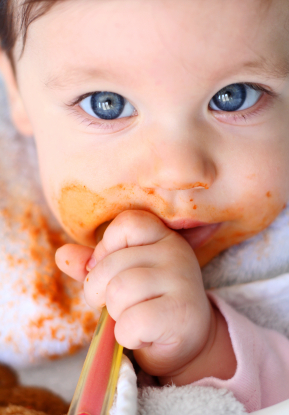When your baby is around 6 months old, she will be ready to start solid foods. Your may be inclined to pop open a jar of Level 1 baby food and go from there, but there are healthier and safer ways to feed your baby. The best way to ensure that your baby is getting fresh food that tastes good is to make it yourself. This sounds more complicated than it is. You can simply steam, boil or bake most foods and then puree using a food mill, grinder, processor or blender. Click here for a list of DIY baby food equipment. The first foods are the easiest – you can simply mash a banana or avocado with a fork and mix in a little filtered water, breast milk or formula if it is too thick. Avoid spinach, celery, carrots and beets until your baby is about seven or eight months old because they can have a high amount of nitrates. Also avoid honey until your child is at least a year old because it can have dangerous bacteria. Avoid certain types of fish (see article on Healthy Eating) and always fully cook meats. And absolutely do not put your baby on a low-fat diet unless advised by a doctor – dietary fat is important for the healthy development of your baby’s brain and immune system.
There are many great cookbooks that provide instructions and recipes for making your baby’s first foods. Try www.weelicious.com or www.wholesomebabyfood.com for recipes. Click here for a list of cookbooks. I recommend making batches of each recipe and then freezing the leftovers in silicone ice cube trays, glass baby food jars or small glass bowls so that you can defrost individual servings as you need them. It is especially important to choose natural and organic ingredients when making your baby’s food (see article on Healthy Eating for Moms and Kids).
If you are limited for time and require convenience, you can stick with prepackaged baby food but choose organic foods. Several companies sell organic baby food in jars and they can be found at most grocery stores. You can also choose frozen organic baby foods. Frozen organic baby foods can be found in specialty grocery stores – look for Homemade Baby, Happy Baby, Sweetpea Baby Food and Plum Organics. These may be harder to find but they usually taste more like fruits and vegetables and less like processed goo. Also, choose premade baby food that comes in glass jars rather than plastic containers that can leach harmful chemicals into your baby’s food (see article about Plastics). For a list of organic jarred baby foods, click here.

When your baby is around 6 months old, she will be ready to start solid foods. You may be inclined to pop open a jar of Level 1 baby food and go from there, but there are healthier and safer ways to feed your baby.
The best way to ensure that your baby is getting fresh food that tastes good is to make it yourself using only natural and organic ingredients. This sounds more complicated than it is. You can simply steam, boil or bake most foods and then puree using a food mill, grinder, processor or blender. Once your baby gets a little older, you can just puree whatever food the rest of the family is having for dinner.
The first foods are the easiest – you can simply mash a banana or avocado with a fork and mix in a little filtered water, breast milk or formula if it is too thick. Avoid spinach, celery, carrots and beets until your baby is about seven or eight months old because they can have a high amount of nitrates. Also avoid honey until your child is at least a year old because it can have dangerous bacteria. Avoid certain types of fish (see article on Healthy Eating) and always fully cook meats. And absolutely do not put your baby on a low-fat diet unless advised by a doctor – dietary fat is important for the healthy development of your baby’s brain and immune system.
There are many great cookbooks that provide instructions and recipes for making your baby’s first foods. You can also try www.weelicious.com or www.wholesomebabyfood.com for recipes. I recommend making batches of each recipe and then freezing the leftovers in silicone or stainless steel ice cube trays, glass baby food jars or small glass bowls so that you can defrost individual servings as you need them. You can freeze the food in ice cube trays and then transfer the cubes to a larger bowl.
If you are limited for time and require convenience, you can stick with prepackaged baby food but choose organic foods in glass jars. Several companies sell organic baby food in jars, and they can be found at most grocery stores. You can also choose frozen organic baby foods. Frozen organic baby foods can be found in specialty grocery stores – look for Homemade Baby, Happy Baby, Sweetpea Baby Food and Plum Organics. These may be harder to find but they usually taste more like fruits and vegetables and less like processed goo. Choose premade baby food that comes in glass jars rather than plastic containers that can leach harmful chemicals into your baby’s food (see article about Plastics).

